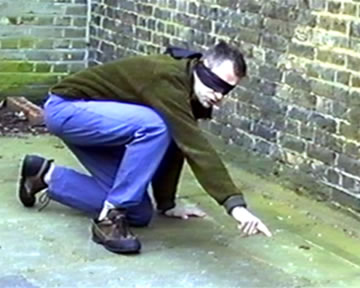Everywhere we explore, we explore with our eyes (that is, those of us lucky enough to have eyes). As humans, our primary sense is sight and we define the world around us through vision – everything has to be seen to be believed, after all. Our reliance on visual interaction is doubly apparent when our ability to see is impaired – every single human being has been scared in or by the dark, partly due to the intrinsic fear of the unknown (which our eyes abate by making it known) and also in part due to our inability to see.
What can we do when sight is denied to us? One of the first instinctive reactions is to thrust out one’s arms and use a bizarre shuffling gait to move around. We try to feel the world around us and it is that instinct, that reaction that I want to examine.
Our eyes deny us the opportunity and motive for tactile exploration – basic human reliance on sight does away with the need to feel the world around you. But how do we cope when we must explore a place physically? What happens when you only know somewhere by touch.
In the house, in the little ante-room beside the living room, I posed myself these two questions. Blindfolding myself with my scarf, I set about discovering the space with a new pair of eyes – my hands. I was inspired, in no small part, by the work of Mark Wayman, who’s work centres around the idea of the disembodied narrative – as the South London gallery’s website describes it, ‘Monologues, describing the surfaces and architectural features of the room in minute and accurate detail, are delivered by Wayman from hidden or obscured locations within it.’ While this does key in to some of my performative ideas that are brewing (or rather, since this post has been delayed for a while, have already come to fruition), my main inspiration comes from his one-off performance wherein he took a small audience round a secluded garden while blindfolded and described the space in minute detail, entirely from memory.

Mark Wayman describing the minutiae of the garden.
I have attempted this within my little ante-room, with favourable results. Once I was free from the yoke of sight, I could (after a fashion) quite easily explore the space, learning the size of things, the room in which I had to move, the texture of different parts of the walls, different parts of the floor. If I stood still, I could become aware of the draft from the little portcullis over near the floor. The heat (or lack thereof) that denoted certain areas was fascinating; with my hands I could judge a thermal map of the room, finding places where the chill was especially strong, the wall directly opposite the draft. Even in the darkness of the blind, the size, shape and layout of this room became as clear to me as it would be if I used my eyes. While blind, I could become part of a space – so intrinsically linked with the proximity of knowledge (for when tactility is your main means of discovery, being close to your surroundings is inevitably) that I could almost become a feature of it. In performance, I want to be part of this space, not merely some inhabitant of it.
REFERENCES:
http://www.liveartwork.com/dvd/current%20issue3.htm (Picture, accessed 22/03/13)
http://www.southlondongallery.org/page/mark-wayman-shifter (Quotation, accessed 22/03/13)